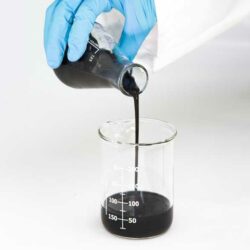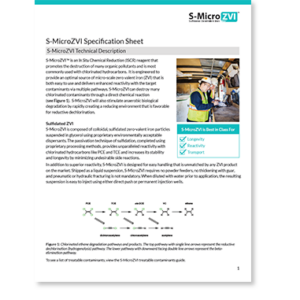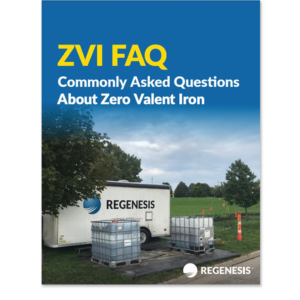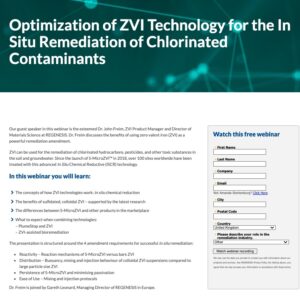
A game-changing zero valent iron technology

S-MicroZVI® is an advanced, liquid form of zero-valent iron to provide highly effective in situ chemical reduction of chlorinated hydrocarbons. S-MicroZVI comprises:
- A liquid format – for safe and easy handling and injection
- Micron-scale Zero Valent Iron (ZVI) particles – to pass through pore throats
- Suspended in water – to create a low viscosity colloidal liquid that distributes further than any other ZVI
- Each particle is coated in iron sulfide to avoid passivation and increase reactivity with the contaminant and longevity
- Glycerol – to acclimate the aquifer and stimulate complimentary biological degradation
Key Benefits
Extreme Longevity
Each ZVI particle is coated in a sulfide layer to maximise contaminant destruction. This sulfidation process results in increased contaminant sorption, reduced reaction with water and avoids oxide build-up.
This means that the treatment will continue for many years – see Longevity Technical Bulletin.
Easy-to-use Liquid
Supplied as a low-viscosity liquid, S-MicroZVI is easily diluted with water and injected into the target aquifer under low pressure.
Safe to use with no dust, no mess, no need for high pressure or specialised equipment! Read the Application Instructions
Unsurpassed Distribution
With an injection radius of up to several metres, S-MicroZVI allows superior contact with contamination, expanding injection grids, reducing cost and time onsite.
Explore project Case Studies
Target Contaminants
- Chlorinated solvents
- Haloalkanes
- Pesticides
- Herbicides
- Energetics
- Hexavalent Chromium Cr(VI)
Complete listing: Range of Treatable Contaminants
Benefits
- Extreme longevity
- Easy-to-use liquid
- Unsurpassed distribution
- Minimises daughter products
- Integrates with other approaches
How does it work?
Combine with other treatment approaches
Customise your remediation strategy to match the technical and commercial needs of the site. S-MicroZVI can be used alone, or in a powerful combination with PlumeStop® (in situ sorption), and AquiFix™ (enhanced anaerobic biodegradation) to immediately remove contamination from the groundwater and degrade it both abiotically and biotically for rapid and long-term results.
Client Feedback
“Great distribution! The product travelled further than we thought”
Environmental Consultant, Scandinavia
“Results have been excellent in a short period of time”
Environmental Consultant, Spain
“Efficient reduction of contaminant concentrations”
Environmental Consultant, UK
“Very easy to handle and inject”
Environmental Contractor, Italy
S-MicroZVI product-specific feedback survey, 2023


 Americas
Americas Europe
Europe Français
Français Deutsch
Deutsch Italiano
Italiano Español
Español




